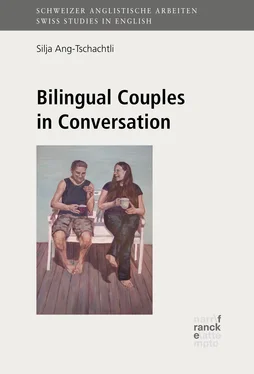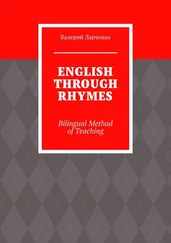In order to examine the modes of communication employed by bilingual, bicultural couples, I interviewed ten heterosexual (cisgendercisgender) couples, each consisting of a native speaker of English and a native speaker of Swiss German. As I intended to examine fluent bilingual communication, I specifically looked for couples who had a high level of proficiencyproficiencyhigh in their relationship language. To ensure that this was the case, I chose couples whose relationship language is English (although one couple uses both languages) and who have been together for a substantial period of timerelationship length (on average 8.3 years).13 The shortest relationship was 1 year at the time of the interview, the longest 24 years. The interviewees’ ages range between 20 and 51 years; the majority of them are in their late twenties or early thirties (on average 30.15 years). On average, the couples met at a fairly young age (between 17.5 and 27, on average 21.85). Seven of the ten couples are married (not surprisingly, the three couples with the youngest average ages are not), and four of them have children. Furthermore, many of the interviewees (16 of 20) have tertiary education or were pursuing a tertiary degree at the time of the interview.
In order to keep other linguistic influences to a minimum, I only interviewed partners who had grown up in a largely monolingual home. It needs to be borne in mind, however, that all of the interviewees have come into contact with other languages, especially the Swiss partners, all of whom studied several languagesmultilingual at school (Standard German, French, English and sometimes other languages such as Spanish or Italian; see also section 2.2, “Multilingualism in Switzerland”). Technically, the Swiss partners are all at least trilingualtrilingual, although their levels of fluency in their L3 and L4 vary greatly. Regardless of which language the participants in this study feel to be their dominant language at present, or which language they currently use the most, I use the term first language first language (orfirst language L1) to refer to the language that they acquired first, which (in this case) is also the language they would call their “mother mother tonguefirst languagetonguemother tonguefirst language”. I consider their most fluent non-native language, which is also their partner’s language in all cases, to be their second language second language (L2), rather than the language they acquired second (which would be French for most of the Swiss participants). All of the participants view Swiss German or English, respectively, as their mother tongue and dominant language. They all learnt their second language in their teens or in adulthood and are thus late (or sequentialsequential bilingualism) bilingualsbilingualismsequential (see Harding and Riley 1986: 47).
All of the Swiss partners are from the German-speaking part of Switzerland, though they speak different dialectsdialectregional. The countries in which the English-speaking partners grew up are England (n=5), the USA (n=3), Australia (n=1) and Northern Ireland (n=1). Nine of the Swiss partners once stayed in an English-speaking country for an extended period of time, most of them for a year (1.05 years on average). Even though eight of the couples met abroad (one met in Switzerland, another one in an English-speaking online forum), all couples except for one were residing in the German-speaking part of Switzerland at the time of the interview.14 On average, the English speakers had been living in Switzerland for 5.8 years. Most of the couples had also had a long-distancerelationshiplong-distance relationship for an extended period of time before settling in Switzerland (on average almost two years).
Finding ten couples who fit my very specific criteria and were willing to participate in an extensive interview turned out to be a difficult undertakingchallengesmethodological, and this is one of the reasons why the interviews took place over a period of several years (see section 4.3, “Interviews”). First of all, many people dislike being recorded (which was also the case for potential subjects in Piller’s [2002a] study), particularly in a non-native language. Some couples expressed worries about their relationship being the subject of the conversation, especially if they were having relationship problems. Moreover, many potential participants I was put in contact with had grown up bilingually themselves or turned out to be non-native speakers who use English as a lingua francalingua franca (ELF), and therefore did not fit my research profile. Several attempts at finding volunteers via social media and newsletters did not lead to any interviews with suitable couples. As a consequence, I decided to also include couples who I was acquainted with (which I initially wanted to avoid as I was a little concerned that this might influence the couples’ answers and conversational behaviour). In a few cases, I knew one or both of the partners quite well; other participants were acquaintances from university or people I had met at social gatherings. Some I had never met prior to the interview, as we had only been in contact via email. In the case of the latter, I was given the couples’ contact details by mutual acquaintances. Although I was sceptical at first, I believe that the interviews ultimately benefitted from the fact that there was always a personal link to the interviewees, direct or indirect, as they were all very open to sharing details about their relationships and to talking about personal or even problematic topics.
In the following, I present an overview of the most important biographic facts about all of the interviewees (Table 1), and then give a brief description of each couple and of their language choicelanguage choicewith each other and use. The couples are introduced in the order of the length of their relationshiprelationship length at the time of the interview (from shortest to longest), which is also the case in all tables involving all participants henceforth. In order to protect the interviewees’ privacy, all the names that are used are pseudonyms.
| Name |
Home country |
Level of education |
Occupation |
Age |
Rel. length |
Married |
Children (number) |
| Robert |
England (Irish parents) |
A-level |
English teacher |
20 years |
1 year |
no |
no |
| Stephanie |
Switzerland |
MA* |
Student |
24 years |
| Tim |
Australia |
Advanced rigger (RA) |
Technician / telecommunications field worker |
29 years |
3 years |
no |
no |
| Sarah |
Switzerland |
BSc* (part-time) |
Student / assistant corporate communication |
23 years |
| David |
England |
BSc |
Senior technology officer IT |
32 years |
5 years |
yes |
no |
| Susanne |
Switzerland |
MA |
English teacher |
29 years |
| Courtney |
England (Ghanaian parents) |
MA* |
Student |
24 years |
5.5 years |
no |
no |
| Martin |
Switzerland |
MA |
Journalist |
26 years |
| Richard |
England |
BA |
Consultant |
29 years |
7 years |
yes |
yes (1) |
| Sophia |
Switzerland |
MA |
History teacher |
31 years |
| Claire |
Northern Ireland |
BSc |
Occupational therapist |
28 years |
8 years |
yes |
no |
| Simon |
Switzerland |
MA |
English teacher |
34 years |
| Dean |
England |
GSCE |
IT recruitment consultant |
29 years |
9 years |
yes |
no |
| Monika |
Switzerland |
MA |
English teacher |
29 years |
| Joshua |
USA |
MA* (part-time) |
Student / legal assistant |
30 years |
10 years |
yes |
yes (2) |
| Deborah |
Switzerland |
Academic baccalaureate (“Matura”) |
Stay-at-home mother |
28 years |
| Craig |
USA |
MSc |
Electrical engineer |
32 years |
10.5 years |
yes |
yes (1) |
| Katia |
Switzerland |
MSc |
PE teacher |
28 years |
| Karen |
USA |
MA |
English teacher |
51 years |
24 years |
yes |
yes (3) |
| Philipp |
Switzerland |
MA |
English teacher |
47 years |
Table 1:
Читать дальше












